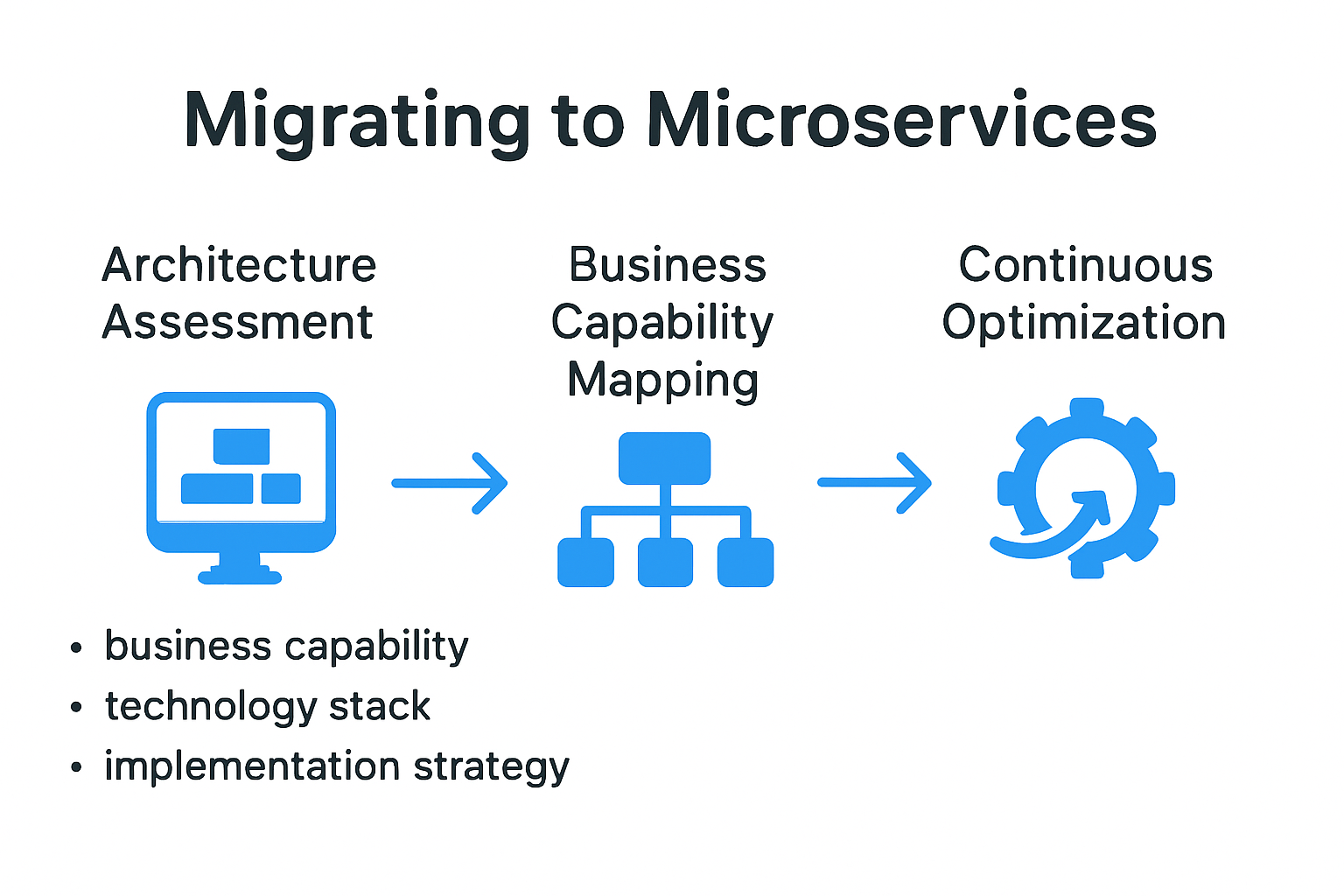Microservices are changing how web development works for businesses everywhere. Some reckon these systems are a hassle, yet companies like Netflix process over 1 billion daily requests thanks to microservices. That number is wild, but what really shakes things up is how South African firms have started using microservices to slash infrastructure costs by up to 30 percent. The big wins come where you least expect them.
Table of Contents
- Understanding Microservices Architecture In Web Development
- Key Benefits Of Microservices For Modern Businesses
- Steps To Implement Microservices In Your Web Projects
- Real-World Examples And Success Stories
Quick Summary
| Takeaway | Explanation |
|---|---|
| Microservices enhance development speed. | They allow independent scaling and simultaneous work on various services, reducing time-to-market significantly. |
| Cost effects are substantial with microservices. | Businesses can cut infrastructure expenses by 20-30% through efficient resource allocation and reduced technical debt. |
| Microservices enable technological diversity. | Different services can use the most suitable technologies, improving system adaptability and innovation capabilities. |
| Robust planning is crucial for implementation. | A thorough assessment of existing architectures and capabilities ensures successful transition to microservices. |
| Real-world success stories exemplify advantages. | Companies like Netflix and Amazon demonstrate enhanced performance and rapid growth through microservices integration. |
Understanding Microservices Architecture in Web Development
Microservices architecture represents a revolutionary approach to web development that transforms how businesses build and manage digital solutions. Unlike traditional monolithic systems where entire applications are developed as a single, interconnected unit, microservices break down complex software into smaller, independently deployable services that communicate through well-defined interfaces.
The Core Principles of Microservices
At its essence, microservices architecture is about creating modular, scalable web applications that can evolve rapidly. Learn more about modern web development strategies to understand how this approach differs from traditional development models.
According to the National Academies Press, microservices enable organisations to construct large applications as a suite of small, independent services. Each service operates autonomously, managing its own database and business logic, which allows for unprecedented flexibility and resilience. This architectural style means that if one service encounters an issue, it doesn’t compromise the entire application’s functionality.
Below is a quick comparison of traditional monolithic architecture and microservices architecture, highlighting their main differences as described in this article:
| Feature / Aspect | Monolithic Architecture | Microservices Architecture |
|---|---|---|
| Structure | Single interconnected application | Multiple independent, modular services |
| Scaling | Entire app must be scaled together | Services can be scaled independently |
| Technology Choice | Usually restricted to single stack | Allows for varied technologies per service |
| Fault Isolation | A fault can bring down the whole system | Faults are isolated to individual services |
| Deployment Speed | Slower, all changes affect the whole system | Faster, independent deployment of services |
| Maintenance | Harder to update without full redeploy | Easier, as individual services can be updated |
Technical and Business Benefits
The advantages of microservices extend far beyond technical flexibility. Research from CMS highlights that microservices facilitate independent development and deployment of application components, dramatically improving scalability and maintainability.
Businesses gain significant strategic advantages through microservices architecture:
- Independent Scaling: Individual services can be scaled independently based on specific computational demands, optimising resource allocation.
- Technology Diversity: Different services can be developed using varied programming languages and technologies best suited to their unique requirements.
- Faster Development Cycles: Teams can work on different services simultaneously, accelerating overall product development and time-to-market.
Moreover, a comprehensive systematic mapping study demonstrates that organisations can strategically transition from monolithic systems to microservices by applying domain-driven design principles. This approach ensures that services are logically structured around business capabilities, not just technical constraints.
The transition to microservices is not merely a technological upgrade but a fundamental reimagining of how web applications are conceived, developed, and maintained. By embracing this architecture, businesses create more resilient, adaptable digital ecosystems capable of responding swiftly to changing market demands and technological innovations.
For forward-thinking organisations, microservices represent more than a trend—they are a strategic imperative in creating robust, scalable web solutions that can evolve as rapidly as the digital landscape itself.
Key Benefits of Microservices for Modern Businesses
In the rapidly evolving digital ecosystem, microservices architecture offers transformative advantages that extend far beyond traditional software development paradigms. For modern businesses seeking agility, efficiency, and competitive edge, microservices represent a strategic technological approach with profound operational implications.
Enhanced Business Flexibility and Innovation
Microservices fundamentally redefine how organisations approach software development and technological adaptation. Explore our comprehensive web development strategies to understand the broader context of digital transformation.
According to a comprehensive analysis by Gartner Research, businesses adopting microservices can achieve up to 50% faster deployment cycles and significantly reduced time-to-market for new features. This architectural approach allows companies to innovate rapidly, test new concepts, and pivot quickly in response to market demands.
Operational Efficiency and Cost Optimisation
The economic benefits of microservices architecture are substantial. Research from McKinsey indicates that organisations implementing microservices can reduce infrastructure costs by 20-30% through more precise resource allocation and improved computational efficiency.
Key operational advantages include:
- Targeted Resource Allocation: Services can be scaled independently based on specific computational requirements.
- Reduced Technological Debt: Easier maintenance and replacement of individual services without disrupting entire systems.
- Improved Fault Isolation: Failures in one service do not cascade across the entire application infrastructure.
Strategic Technological Resilience
Microservices architecture enables businesses to build more robust and adaptable technological ecosystems. By decoupling services, organisations create a more resilient infrastructure that can quickly respond to changing business needs.
The International Data Corporation (IDC) suggests that companies leveraging microservices experience 40% faster innovation cycles and can more effectively integrate emerging technologies. This approach allows businesses to:
- Experiment with new technologies in specific services
- Integrate cutting-edge solutions without comprehensive system redesigns
- Maintain technological relevance in a rapidly changing digital landscape
For South African businesses navigating complex digital transformation challenges, microservices offer a pragmatic pathway to building scalable, efficient, and future-ready technological solutions. The architecture represents more than a technical strategy it is a fundamental approach to creating adaptive, responsive digital infrastructures that can drive competitive advantage.
By embracing microservices, businesses position themselves to not just survive but thrive in an increasingly digital and interconnected global marketplace.
Steps to Implement Microservices in Your Web Projects
Implementing microservices architecture requires a strategic and methodical approach that goes beyond simple technological migration. Businesses must carefully plan and execute their transition to ensure successful digital transformation and optimal system performance.
Here’s a summary table outlining the key steps and checkpoints for implementing microservices in your web projects, as detailed in the guide above:
| Phase | Key Activities | Main Outcomes |
|---|---|---|
| Assessment & Planning | - Map business capabilities - Analyse performance & tech stack |
Clear service boundaries, readiness |
| Technical Implementation | - Set up DevOps teams - Develop inter-service communication |
Agility, robust deployment |
| Monitoring & Optimization | - Monitor services - CI/CD, regular audits |
System resilience, ongoing improvement |
Foundational Assessment and Planning
Explore our comprehensive web development strategies to understand the broader context of architectural transitions. According to Atlassian’s comprehensive guide, organisations should begin by thoroughly understanding their existing monolithic architecture before embarking on microservices implementation.
Key initial steps include:
- Business Capability Mapping: Identify distinct business functions that can become independent services
- Performance Requirements Analysis: Evaluate computational demands and scalability needs
- Technology Stack Evaluation: Determine appropriate frameworks and programming languages
Technical Implementation Strategy
TechTarget highlights six critical deployment steps for successfully transitioning to microservices in production environments. The recommended approach involves creating cross-functional teams with a robust DevOps culture, replacing traditional IT silos with more agile, communicative structures.
Critical technical considerations include:
- Implementing robust inter-service communication protocols
- Designing comprehensive monitoring and logging mechanisms
- Establishing standardised service discovery and configuration management
Continuous Evolution and Optimization
Microservices implementation is not a one-time project but an ongoing evolutionary process. A practical workshop from GitHub demonstrates advanced techniques for building microservices stacks using modern frameworks like Spring Boot and Spring Cloud.
Ongoing optimization strategies involve:
- Regular performance auditing of individual services
- Continuous integration and deployment (CI/CD) pipeline refinement
- Periodic reassessment of service boundaries and architectural design
For South African businesses, microservices implementation represents a significant technological leap. The process demands not just technical expertise but a holistic understanding of how modular architectures can drive business innovation and operational efficiency.
Successful microservices adoption requires patience, strategic planning, and a willingness to embrace continuous learning and adaptation. By approaching the transition methodically and maintaining a flexible mindset, organisations can build robust, scalable digital ecosystems that respond dynamically to evolving market demands.

Real-World Examples and Success Stories
Microservices architecture has transformed digital strategies for numerous global organisations, demonstrating its potential to revolutionise business technology infrastructure. Discover how digital transformation impacts modern businesses to understand the broader context of technological innovation.
Enterprise Level Transformation
Netflix stands as a quintessential example of microservices success. According to Amazon Web Services, Netflix migrated from a monolithic architecture to microservices, enabling them to handle over 1 billion requests per day with unprecedented reliability. Their approach involved breaking down complex systems into approximately 700 microservices, each responsible for specific functionalities like user authentication, recommendation engines, and streaming protocols.
Similarly, Uber’s engineering team demonstrated how microservices could support hypergrowth. By implementing a distributed architectural approach, Uber could scale its technological infrastructure to support millions of daily rides across global markets, with each service managing distinct operational requirements like payment processing, driver matching, and route optimization.
Financial Services Innovations
The financial sector has also embraced microservices to enhance digital banking experiences. Case studies from McKinsey reveal that institutions like Capital One have successfully implemented microservices to accelerate software delivery, reduce infrastructure costs, and improve customer experience.
Key transformational benefits observed include:
- Rapid Deployment: Reducing software release cycles from months to weeks
- Enhanced Scalability: Managing fluctuating computational demands efficiently
- Improved Fault Isolation: Minimising system-wide disruptions during individual service failures
Technology and E-commerce Breakthroughs
Amazon provides another compelling narrative of microservices implementation. By transitioning from a monolithic platform to a microservices-based architecture, Amazon could process over 1.6 billion e-commerce transactions annually, with each microservice handling specific aspects of their complex online marketplace.
Companies like Spotify have also leveraged microservices to personalise user experiences. Their architectural approach allows real-time music recommendation algorithms to operate independently, ensuring seamless performance and personalised content delivery across millions of user profiles.
For South African businesses, these global success stories illustrate more than technological trends. They represent strategic approaches to building resilient, adaptable digital infrastructures that can rapidly respond to market dynamics and customer expectations.
The journey towards microservices is not about wholesale replacement of existing systems but thoughtful, incremental transformation. By learning from these pioneering examples, organisations can develop nuanced strategies that align technological capabilities with specific business objectives, creating more agile and responsive digital ecosystems.

Frequently Asked Questions
What are microservices in web development?
Microservices are an architectural style that structures an application as a collection of small, independently deployable services that communicate through well-defined APIs. This allows for more flexible and scalable web development compared to traditional monolithic architectures.
What are the benefits of using microservices for businesses?
Businesses can experience enhanced flexibility, faster deployment cycles, reduced infrastructure costs, and improved fault isolation by using microservices. This approach allows teams to work on different services simultaneously and quickly adapt to changing market demands.
How can companies implement microservices in their web projects?
Implementing microservices requires a strategic approach, including foundational assessment, planning service boundaries based on business capabilities, adopting a robust technical implementation strategy, and continuously optimizing services through regular audits and refinements.
Can microservices help reduce costs in web development?
Yes, organizations can potentially reduce infrastructure costs by 20-30% through precise resource allocation and reduced technical debt. Independent scaling and easier maintenance of individual services contribute to overall cost optimization.
Ready to Transform Your Business with Microservices?
If your business is feeling trapped by slow, hard-to-update web systems, you are not alone. Many companies reach a point where old monolithic architecture stunts growth and flexibility. The article above explored how microservices can unlock speed, resilience, and cost savings for forward-thinking organisations. You want freedom to innovate, scale only the services you need, and keep your technology as adaptable as your market. That is exactly where Cloudfusion’s expertise can step in.
Take the stress out of digital transformation. Our team at Cloudfusion has firsthand experience crafting industry-specific platforms using the modular approach described in this guide. Let us help you map your business capabilities, structure your services for independent scaling, and future-proof every aspect of your digital infrastructure. Move from insight to action by requesting a custom web development quotation today. Give your business the flexibility and reliability it deserves—get started now and lead the digital game.








